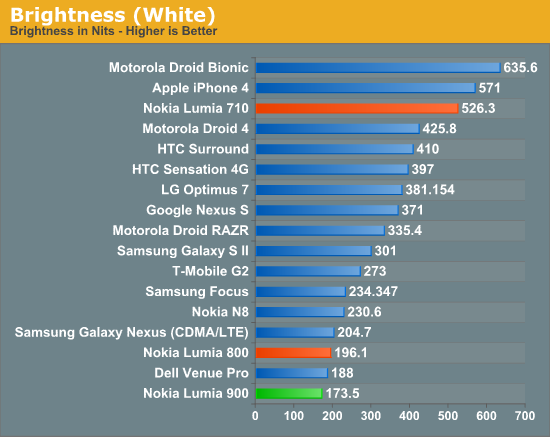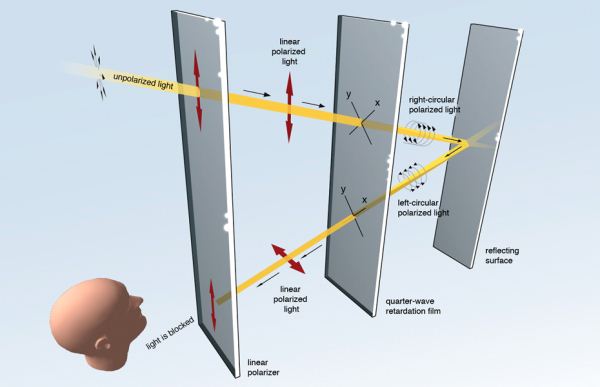Nokia Lumia 900 Review - Windows Phone with LTE
by Brian Klug on April 3, 2012 9:00 PM ESTDisplay Quality
Like the Lumia 800, the Lumia 900 uses an AMOLED display instead of an LCD. One of the chief differentiators between the two models however is the difference in subpixel rendering. Whereas the Lumia 800 used a 3.7“ PenTile RGBG SAMOLED panel, the Lumia 900 uses a 4.3” SAMOLED+ panel with an RGB subpixel stripe. Those names fit, that is, if we’re following Samsung’s naming scheme, and as an aside this is undoubtedly a Samsung panel.
The effective resolution of both displays are 800x480 WVGA, like all Windows Phones, however. Jumping up in display size pretty much necessitates that change to RGB, since PenTile really only works when subpixels are below human visual acuity. In addition, we’ve already seen 4.3" SAMOLED+ WVGA displays out of Samsung (see the Focus S).
I measured the Lumia 900 display using an i1D2 just like I’ve done with numerous other smartphones, though at this point the advanced color and gamut information will have to wait until I make some targets. Again, because AMOLED is emissive, black color pixels are literally off, so contrast graphs are omitted. The Lumia 900 doesn’t go super bright, like other AMOLEDs I’ve seen. In fact, it’s slightly dimmer than the Lumia 800’s maximum of 196 nits. Remember that going to a larger display, especially AMOLED due to its emissive nature, increases power demands as r^2 since we’re talking about areal size.
| Lumia 900 Display Metrics | |||
| Brightness Level | Black Brightness (nits) | White Brightness (nits) | White Point (K) |
| Low | 0 | 72.68 | 6635 |
| Medium | 0 | 140.06 | 6930 |
| High | 0 | 173.55 | 6812 |
Nokia was able to get the Lumia 900 display nice and close to 6500K, which is interesting considering how many other AMOLED displays I’ve seen which are up near 8000K or higher and noticeably blue all the time.

I glossed over ClearBlack on the previous Lumia reviews partly due to time constraints, partly due to not knowing the exact details of their optical path. That said, it was immediately obvious that the system used circular polarization’s behavior upon reflection to attenuate back reflections. However, since writing those reviews, Nokia has outlined their optical system in a conversations post, and the long and short of it is that the system consists of a linear polarizer and quarter-wave plate.
Incoming diffuse light gets vertically polarized by a surface polarizer, which becomes right hand circularly polarized when passing through the quarter wave plate. When circular polarized reflects off of a surface, it changes handedness - in this case from right to left handed circular. Upon passing through the quarter wave plate on its way out, this becomes horizontally polarized, which is then strongly attenuated by the surface polarizer with its fast axis aligned vertically on its way out, which acts like an analyzer. The end result is that outdoors the only reflection you’ll get is from the first surface, not the surface of the display itself, which does reduce resulting glare.
This change also permits the Lumia 900 to still look bright outside, and in turn allows Nokia to run the display at a lower brightness and save some amount of power. For a while I was waiting for some OEM to introduce a system using polarization to diminish back reflections, and Nokia has done it with ClearBlack.
Indoor viewing angles for the Lumia 900 are excellent as evidenced by the purple test pattern from WP Bench not changing color at extreme field angles. In addition, I subjectively can’t find any issues with the display - there are none of the other problems that affect the higher dot pitch AMOLEDs such as grain or mura. Outdoor viewing angles are likewise good for the Lumia 900 in part thanks to ClearBlack.

















128 Comments
View All Comments
RaistlinZ - Tuesday, April 3, 2012 - link
2010 would have liked this phone.guidryp - Tuesday, April 3, 2012 - link
Yeah, why are they getting a pass on a single core phone with abysmal browser performance as their flagship offering.hemmy - Wednesday, April 4, 2012 - link
Abysmal? Please. Yes the benchmarks are poor but the browsing experience is significantly better than any Android phone with the sheer smoothness.eddman - Wednesday, April 4, 2012 - link
I was watching a video the other day, showing scrolling and zooming in verge and engadget, which are very heavy websites, and was really surprised by how much fast and smooth WP is when it comes to browsing.I don't suppose a single-core android phone can be that smooth.
Braumin - Wednesday, April 4, 2012 - link
Because life isn't about benchmarks.juhatus - Wednesday, April 4, 2012 - link
Totally wrong. Life is a benchmark.Now I need my milliseconds back.
PeteH - Thursday, April 5, 2012 - link
But without something to measure myself against, how will I know if I'm winning?TGressus - Wednesday, April 4, 2012 - link
2010 would have used a browser.p~
Seriously though, when you have to zoom and pan to view content, doesn't it feel like you are using the wrong device to begin with?
jwcalla - Tuesday, April 3, 2012 - link
As a software developer I can say that I've had nothing but heartache dealing with Qualcomm hardware so far. Closed-up proprietary stuff with no public API to help us out seems to be the preferred mode of operation.Ultimately a platform comes down to its developers. There are a limited number of developers and the platform that attracts the most and best from the lot is going to provide the greatest user experience. Apple figured this out long ago in the device space. Microsoft before that on the desktop. If Nokia and Microsoft understand this today, they'll do well.
I don't care how well the hardware benchmarks, we need to be treated as something other than an afterthought if you want us to develop for your platform.
Braumin - Wednesday, April 4, 2012 - link
I'm sorry how is Visual Studio not the best for developers? Are you trying to write native code to WP7? I know it can be done, but most apps don't do it.I think the developer tools are top notch for WP7.5. Sure, there are some holes to fill (WP8) but they will get filled.